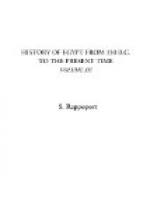* This is a peculiarly interesting suggestion in view of the fact that there is in the British Museum an unpublished fragment which for some time was considered by Doctor Budge to be a species of Egyptian stenography, but which has also been suggested to be in Pehlevi characters.
The new Homeric fragments include one of Iliad VI., with critical signs and interesting textual notes. Sappho, Euripides (Andromache, “Archelaus,” and “Medea"), Antiphanes, Thucydides, Plato ("Gorgias” and “Republic"), AEschines, Demosthenes, and Xenophon are also represented. Among the theological texts are fragments of the lost Greek original of the “Apocalypse of Baruch” and of the missing Greek conclusion of the “Shepherd” of Hennas.
In the winter of 1898-99, Doctors Grenfell and Hunt conducted excavations for the Graeco-Roman Branch in the Fayum. In 1899-1900, they excavated at Tebtunis, in the Fayum, on behalf of the University of California; and by an arrangement between that university and the Egypt Exploration Fund an important section of the Tebtunis papyri, consisting of second-century B.C. papyri from crocodile mummies, was issued jointly by the two bodies, forming the annual volumes of the Graeco-Roman Branch for 1900-01 and 1901-02. Since 1900 Doctors Grenfell and Hunt have excavated each winter on behalf of the Graeco-Roman Branch,—in 1900-01 in the Fayum, and in 1901-02 both there and at Hibeh, with the result that a very large collection of Ptolemaic papyri was obtained. In the winter of 1902-03, after finishing their work at Hibeh, they returned to Oxyrrhynchos. Here was found a third-century fragment of a collection of sayings of Jesus, similar in style to the so-called “Logia” discovered at Oxyrrhynchos in 1897. As in that papyrus, the separate sayings are introduced by the words “Jesus saith,” and are for the most part unrecorded elsewhere, though some which are found in the Gospels (e.g. “The Kingdom of God is within you” and “Many that are first shall be last, and the last shall be first”) occur here in different surroundings. Six sayings are preserved, unfortunately in an imperfect condition. But the new “Logia” papyrus supplies more evidence concerning its origin than was the case with its predecessor, for it contains an introductory paragraph stating that what follows consisted of “the words which Jesus, the Living Lord, spake” to two of His disciples; and, moreover, one of the uncanonical sayings is already extant in part, the conclusion of it, “He that wonders shall reign and he that reigns shall rest,” being quoted by Clement of Alexandria from the Gospel according to the Hebrews. It is, indeed, possible that this Gospel was the source from which all this second series of “Logia” was derived, or they, or some of them, may perhaps have been taken from the Gospel according to the Egyptians, to which Professor Harnack and others have referred the “Logia” found in 1897. But the discoverers are disposed to regard both series as collections of sayings currently ascribed to our Lord rather than as extracts from any one uncanonical gospel.




